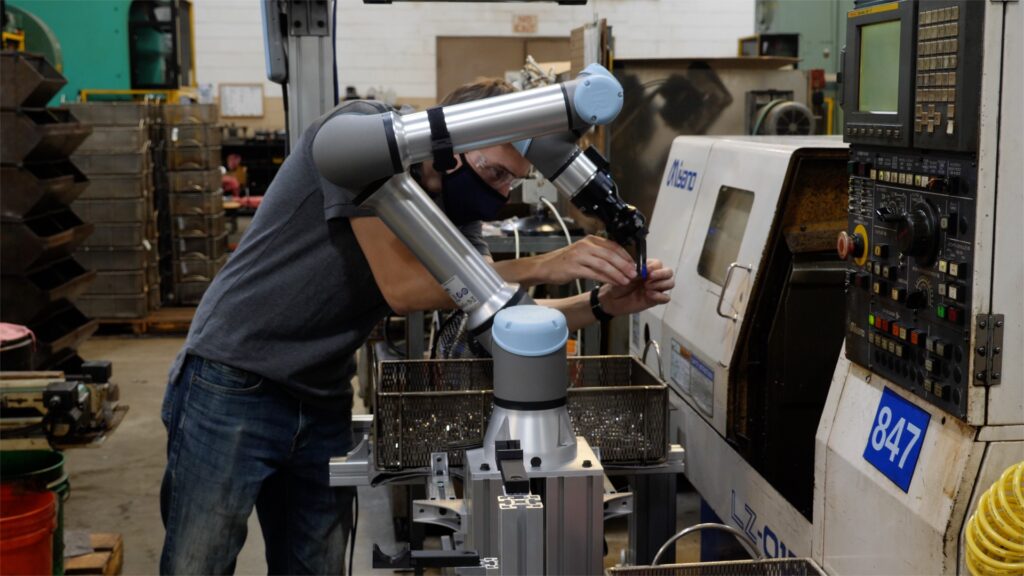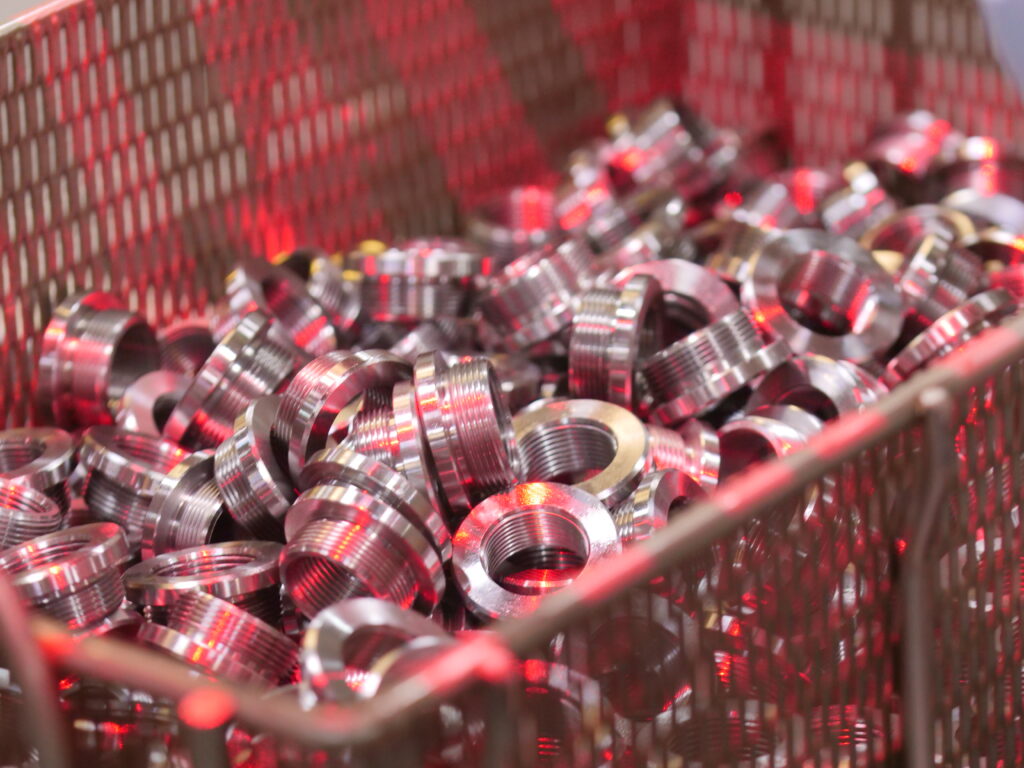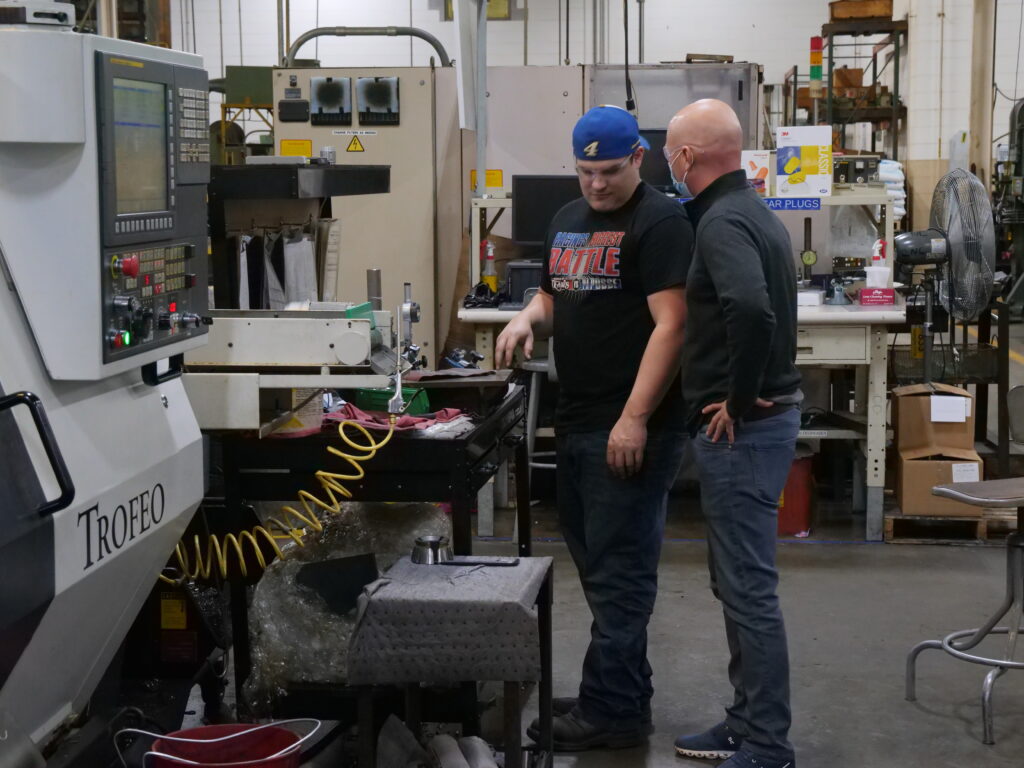PrecisionForm, a market leader in small custom metal parts, was challenged to automate the task of picking parts in deep bins and inserting them into a CNC machine. The company deployed Universal Robots’ ActiNav system for flexible machine loading, enabling them to boost competitiveness, overcome labor challenges, empower their workforce and extend the lifespan of older equipment.
What’s the biggest headache in automating a task? How to present the part to the robot. This was the conclusion PrecisionForm quickly reached when automating their initial project; deploying a robot to pick piston rings and place them on a micrometer for inspection. Like many parts at the Pennsylvania-based contract manufacturer, the rings were batch processed and arrived in big bins, all jumbled together. In order for the cobot to pick them, an operator had to lay them out in a grid pattern on a tray first.
“50-75 percent of our time spent getting that application up and running was figuring out how the robot would pick the parts,” says Alex Corckran, president and CEO of PrecisionForm. “Having an operator lay out parts for the cobot was still faster than doing the whole inspection process manually, but wouldn’t it be nice if the cobot could just pick directly from the bin and bypass this whole step?”
PrecisionForm started researching bin picking solutions for the next project, picking parts out of bins for CNC milling. The company contacted a number of vendors and sent sample parts to determine if they could be picked out of bins. “The answers were always, ‘Yes: but…’ and the “buts” were never acceptable to us,” says Corckran, recalling how some systems had trouble with parts that were certain colors, others had issues with flat parts, while some systems required the vendor’s engineer to come out and handle the changeover from one part to the next.
 “We have 50 to 100 parts that we touch on a weekly basis for inspection or secondary processes,” says the PrecisionForm CEO. “The vast majority of those parts are not high enough quantities to justify having a fully automated solution that we can’t easily switch between parts.”
“We have 50 to 100 parts that we touch on a weekly basis for inspection or secondary processes,” says the PrecisionForm CEO. “The vast majority of those parts are not high enough quantities to justify having a fully automated solution that we can’t easily switch between parts.”
Using a bowl feeder for part presentation wasn’t an option either, explains Corckran. “Bowl feeders are effective when you have very high volumes and you have the right part for the job. For other parts, when you have lower volumes, the changeover between one part to the next on a bowl feeder is either impossible, or just takes too long to make it effective. In many cases, it’s just easier to have a person do that work rather than switch over the automation process.”
Enter ActiNav
When Universal Robots (UR) and UR distributor Applied Controls reached out to PrecisionForm to suggest a test of the ActiNav solution, Corckran was skeptical: “We figured it was going to be the same as all the other bin-picking solutions, where we send them a part and weeks later they send us a ‘But.’” Nevertheless, PrecisionForm sent the ActiNav team sample parts along with CAD drawings and 3D models. “We were actually shocked,” says Corckran. “We sent them two parts, including one with a very small, flat surface that never sits in the bin properly and within 24 hours they had sent us three demo videos of ActiNav actually picking the parts out of a bin.”
A UR cobot, when combined with an award-winning ActiNav Machine Loading kit creates a flexible and easy-to-use machine loading solution. The kit consists of hardware and software that integrate seamlessly with the cobot to synchronously handle vision processing, collision-free motion planning, and autonomous real-time robot control.
Simple Automation
Choice PrecisionForm already owned a UR3 and a UR5 cobot from Universal Robots; the UR3 handles the initial piston ring inspection process and the UR5 loads and unloads parts in a brake press. Building on its positive experiences with Universal Robots’ cobots and the impressive results of the initial bin picking samples, PrecisionForm decided to purchase an additional UR5 fitted with the ActiNav solution and deploy it for a very simple, low-hanging fruit task; picking firearm parts out of a bin and loading them into a CNC machine. The task has a cycle time of 90 seconds and requires one full-time operator to tend it, making it a perfect task to automate.
The ActiNav system took maybe a day to set up and deploy, says Dan Vazquez, industrial automation engineer at PrecisionForm: “The first step is to define the environment and calibrate the sensors, which is very straightforward. You drag the robot arm to points where you want to place environment objects and once you define those points, the robot will autonomously plan its paths based on that information.” Next, Vazquez simply fed the cobot a CAD file of the part to be picked. “ActiNav will be able to identify the part within the bin, as well as its position on the end effector while it also autonomously plans further movements,” he explains, adding that PrecisionForm implemented two re-grip stations in the cycle where parts are placed to optimize cycle time and give the cobot the correct angle to pick the part for final placement.
 The Solution
The Solution
First ActiNav scans the bin. Once it has identified pickable parts that the UR5 can reach and safely move to a re-grip station, the robot picks the part, verifies that it has picked the part, and moves to the re-grip station. Then the UR5 removes the finished part from inside the CNC lathe, places it on second re-grip station, and moves to the first regrip station to insert the blank part into the lathe. While that part is being milled, ActiNav returns to the second re-grip station to place the finished part into a palletized pattern in a box. “The whole cycle time— a minute and a half to two and a half minutes—it’s extremely efficient for us to have a robot doing that,” says Corckran.
Actinav Empowers Workers, Solves Labor Challenges
PrecisionForm can’t be competitive at an international level from Lititz, Pennsylvania with one operator running one machine at a time, says Corckran: “We have a whole lot of very skilled workers. A lot of these very repetitive tasks are intermittent, so we often find ourselves having to take a highly-skilled person and put them on a very repetitive task, and that’s not great for morale, and it’s not cost-effective either.”
Following the ActiNav deployment, operators can run three or four machines at a time, enabling the company to stay competitive: “This solution enables us to have highly-trained people operating three or four robots, allowing us to use those people in other applications where they’re adding more value.” In Corckran’s experience, when temporary labor is required to take on intermittent tasks, finding “good, qualified folks to show up on a regular basis when you need them” is a challenge. ActiNav solves that problem: “The robot stays there and doesn’t take a break and it works second shift, third shift, and we can count on it being there the next day.”
UR+ Certified Robotiq Gripper
Initially, PrecisionForm had difficulties picking the part out of the CNC lathe because the part was covered in cutting fluid and placed inside very tight quarters. The company equipped the UR5 cobot arm with the Hand-E gripper from Robotiq. Hand-E is a UR+ certified gripper which means it seamlessly integrates with the UR cobot. “The ability of the Robotiq gripper to adapt to new fingers that we designed made it possible to reach in there and pull the part out accurately,” says Vazquez.
The gripper is controlled directly through the cobot’s teach pendant. “This is great because you end up being able to have very minute control over the grippers’ movements, as well as the force applied,” explains the industrial automation engineer. “The robot can also use this force feedback to tell whether or not it has picked the part up, or if it may have dropped it. For other applications where we’ve used pneumatic grippers, we typically need to run air lines along the outside of the robot, which causes issues with wear and tangling. The Hand-E connects directly to the cobot’s tool input, so there’s no cables to be tangled.”

Inspection With Actinav Gives Legacy Equipment Another 10 Years On The Floor
PrecisionForm’s manufacturing facility combines the “latest-and-greatest CNC equipment” with “30-year old equipment that’s still very effective at its job,” says Corckran. The ability to implement ActiNav on older equipment doesn’t just have the obvious ROI of replacing an operator or allowing a single operator to operate four machines, explains Corckran, it allows companies to rethink whether or not that piece of equipment needs to be replaced.
“For example, we have some machines that produce very high-volume parts, in the millions a year. At some point, those machines wear out, and they stop producing 100 percent, or 99.999 percent good parts. In the old reality, we would have to replace that machine to stay competitive,” he says. “However, if we can implement ActiNav next to that machine and inspect out the one percent of bad parts, we’ve just taken a million dollar piece of equipment, added a very inexpensive solution to it, and potentially gotten another ten years out of it.”
The tolerances of parts manufactured at PrecisionForm are very tight with customers scrutinizing every part. In order to keep the company’s old equipment producing at the level customers expect, the operators stop once an hour for ten to fifteen minutes and do a full inspection of both the part and the die. “That’s as much as 15 to 20 percent of daily production lost, that we can now recuperate using ActiNav” concludes Corckran, adding that in future application scenarios, PrecisionForm envisages also using an additional ActiNav system on its first piston ring inspection application, eliminating the manually-loaded trays.
Significant Market Need
Any type of unoriented presentation process is a perfect fit for ActiNav says Chuck Mulcrone, Vice President of Sales with Applied Controls, that distributes Universal Robots in the Mid-Atlantic region. “Historically, in the 3D bin-picking, batch processing market, the cost of entry is prohibitive for most small companies. ActiNav is a game-changer addressing a significant market need in automating high-mix, low-volume production with unstructured parts to be picked,” he says. “It’s a relatively low-cost, low-engineering product and it goes across every industry; from automotive to food and beverage to material handling.”
About PrecisionForm:
Originally a division of Alcoa Inc., PrecisionForm Inc. is a contract metal component manufacturer based in Lititz, Pennsylvania. In the more than 32 years since its founding, PrecisionForm has become a leader in custom small parts manufacturing for the automotive, electrical, electronics, aerospace and building sectors. PrecisionForm utilizes both multi-die progressive cold forming and machining techniques, while rotary transfer machines, CNC lathes and machining centers provide automatic station-to-station indexing for accurate secondary operations, enabling the company to minimize raw material cost and eliminate waste.
About Universal Robots:
Universal Robots (UR) was founded in 2005 to make robot technology accessible to all by developing small, user-friendly, reasonably priced, flexible collaborative robots (cobots) that are safe to work side by side with people. Since the first cobot was launched in 2008, the company has experienced considerable growth with the user-friendly cobot now sold worldwide. The company, which is a part of Teradyne Inc., is headquartered in Odense, Denmark, and has regional offices in the United States, Germany, France, Spain, Italy, UK, Czech Republic, Poland, Hungary, Romania, Russia, Turkey, China, India, Singapore, Japan, South Korea, Taiwan and Mexico. In 2019, Universal Robots had a revenue of USD 248 million.











































